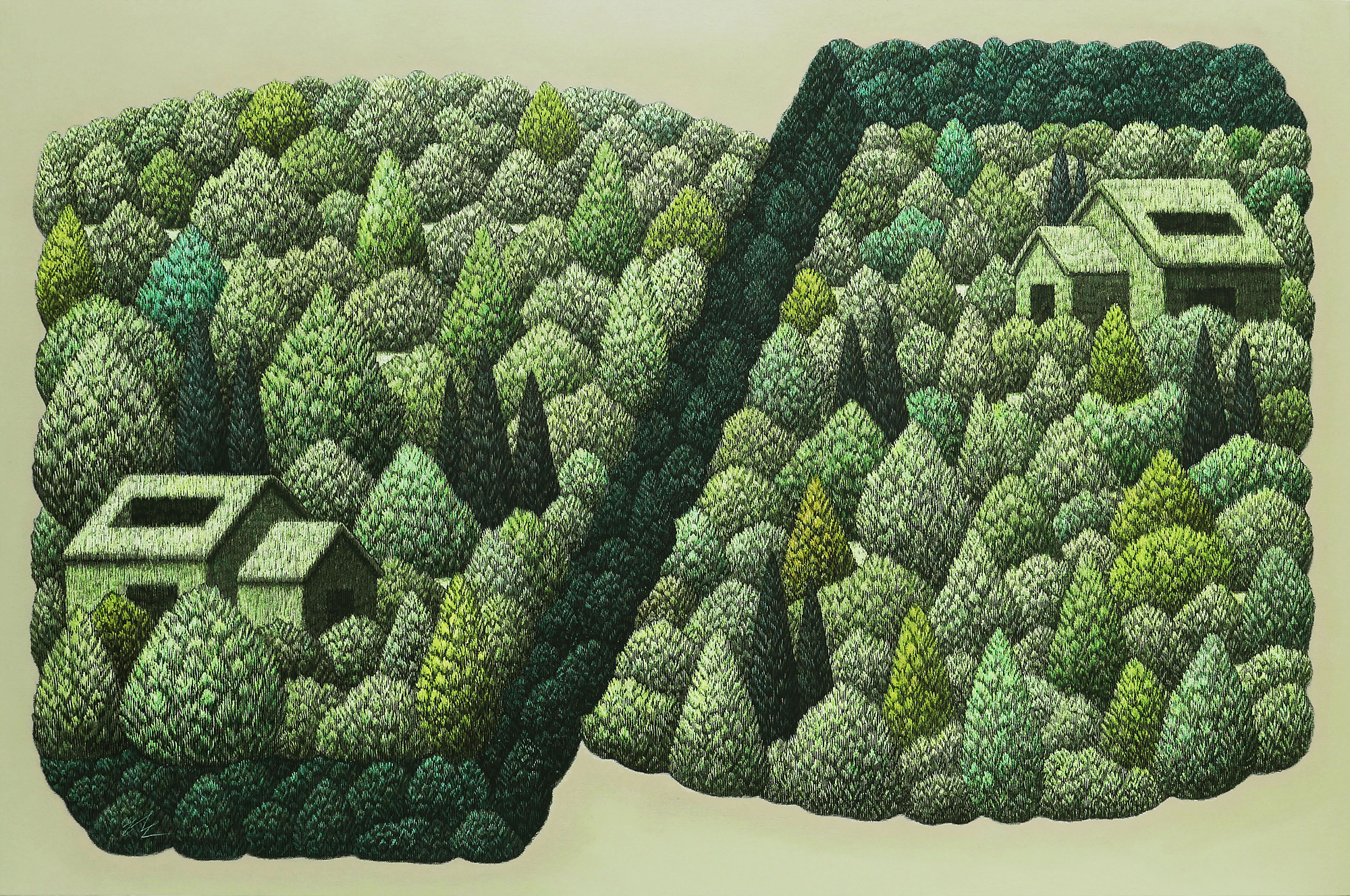권대섭展
| [GALLERIES] Johyun Gallery
2021. 1. 14 – 2021. 3. 28
권대섭

권대섭은 1952년 서울에서 태어나 1978년 홍익대학교 미술대학 서양화과를 졸업후 우연히 인사동에서 백자를 본뒤 1979년부터 5년간 일본 규슈 오가사와라 도예몬에서 도자를 배웠다. 1995년 덕원미술관에서 국내 첫 전시를 열었다. 이후 서미앤투스 갤러리 (2009~2014), 악셀 베르보르트 갤러리 (2015,2018/벨기에), 박여숙화랑 (2019,2020)에서 개인전을 가졌다. 2009년 디자인 마이애미와 이탈리아 밀라노 트리엔날레 (2013)에 참여하였다. 서울미술관 (2014), 중국 마운틴 아트재단에서의 순회 전시 (2014), 한불수교 130 주년을 기념하여 파리장식미술관 (2015)에서 그룹전을 했으며, 바이에른 국립 박물관(독일 뮌헨 2016), 아트 몬테 카를로(모나코 2016), 아트 제네바(스위스 2016), 도쿄 긴자 식스 갤러리(일본 2017) 등에서 다양한 전시를 했다. 1998년 한국예술평론가협회 최우수 예술인으로 선정, 현재 리움 삼성미술관, 한국민속박물관, 기메 미술관(프랑스), 상트페테르부르크 국립 박물관(러시아), 시카고 인스티튜트 오브 아트(미국) 등 다양한 나라에 작품이 소장되어 있다.
조현화랑은 2021년 첫 전시로 권대섭 작가의 개인전을 개최한다. 본 전시에서는 조선 백자의 전통적인 방식을 현대적으로 해석한 권대섭의 백자 항아리 신작 11점을 공개한다. 대학 시절부터 골동품을 보러 다니는 취미가 있었던 작가는 20대 후반 인사동에서 조선백자를 본 후 그 아름다움에 매료된다. 홍익대에서 서양미술을 전공했지만, 장르와 매체에 연연하지 않고 우리의 전통문화를 근간으로 한 도예 작업에 40년이 넘는 시간동안 매진하게 된다.

조선백자의 전통적 방식 계승
우리가 흔히 ‘달항아리’라고 부르는 백자는 17세기 후반부터 18세기 사이 조선왕조에서 왕성하게 제작된 자기를 말한다. 권대섭의 백자는 그 시기의 형식과 제작방식을 충실히 따른다. 형태는 높이 40cm가 넘은 원형으로 유백색 혹은 설백색이라 칭하는 우윳빛이다. 재료 또한 입자가 곱고 불순물이 완전히 제거된 질 좋은 고령토만을 사용한다. 가마에서 불은 최고 1,400℃ 이상까지 올릴 수 있어야 한다. 원재료가 되는 흙의 선택부터 불 온도를 끌어올리는 기술까지 조선시대 도공들이 수준 높은 노하우를 모두 체득했다. 이러한 방식으로 작가는 1년에 10회 내외로 가마를 가동시킨다. 한번에 4개씩 총 40여개를 굽지만 엄격한 기준에 의해 최종적으로 완성되는 작품은 50%이내인 20개가 채 되지 않는다. 현재 작업실이 위치한 경기도 광주는 조선 왕실 도자기를 구웠던 관요(官窯)가 있던 장소로 340여개에 이르는 가마터가 있던 지역이다. 작가는 1979년 일본 오가사와라 도예몬에서 수학 하고 한국으로 돌아와 광주에 가마를 지었다. 그리고 옛 도요지를 찾아다니며 도공들의 흔적을 찾고 연구했다. 결국 조선시대 자기의 재료와 형태, 제작과정 뿐만 아니라 왕실 도자기의 기운까지도 계승하고 있는 것이다.
현대적 감각으로의 재해석
그렇다고 조선의 백자를 마냥 답습하는 것은 아니다. 전통문화에 뿌리를 둔 채 자신만의 현대성을 시도하고 있다. 본 전시에서 선보이는 권대섭의 작품은 형태적인 유형에 따라 원호(혹은 환호圓壺)와 입호(立壺)로 나뉜다. 둥글고 하얀 형태가 꽉 찬 보름달과 같다고 하여 ‘달항아리’라는 별칭이 생긴 원호는 두 개의 반구를 위 아래로 이은 형태다. 두 개의 사발을 포개는 방식에서 중요한 기술은 바로 가운데 이음매에 있다. 각각의 반구가 정 반원이었다면 둘을 연결하는 작업이 편리했을 테지만 권대섭의 항아리는 전체적으로 약간 이지러진 모양새다. 상·하 접합과정에서 이지러짐의 정도와 모양을 계산한 것이다. 덕분에 완벽한 비례를 거부하면서도 균형을 잃지 않는다. 원형을 탈피해 어리숙해 보이는 형태에도 안정감과 편안함이 있다. 표면의 질감 또한 다채롭다. 조형 작품처럼 모든 면을 둘러가면서 관찰해야 한다. 어느 부분은 반질반질 윤이 아니고 어느 부분은 탁하고 뿌옇다. 이는 작가가 가마 내부에서 불의 온도를 부분적으로 조절함으로써 얻은 변칙의 맛이다. 작가는 자신의 작품이 ‘달항아리’라는 이름으로 규정되는 것을 경계한다. 조선시대의 달 항아리와는 분명 다를뿐더러, 보름달의 이미지는 상상과 해석의 여지를 제한하기 때문이다.
과거와 현재를 아우르는 순정의 미
“나무에는 나무의 맛이, 돌에는 돌의 맛이 있습니다. 그러한 자연의 맛과 아름다움을 해하지 않으면서 작가의 솜씨가 더해진 작품이 좋은 작품입니다.”는 작가의 말처럼 잘 만들어진 작품과 유물은 단순하고 순수한 멋이 깃들어져 있다. 권대섭의 백자에 담긴 담백한 순정의 미는 절제된 아름다움을 지닌 한국적 정서와 작가의 현대적 감각이 더해져 예술적 가치를 높인다. 작가는 ‘현대성’에 대해 ‘단지 우리가 보지 못한 새로운 면’이라 표현했다. 새로움을 의미하는 한자 ‘新’(새 신)을 분리해 보면 木(나무 목) 옆에 斤(도끼 근)으로 이루어져 나무를 도끼로 베는 모양새다. 전통이라는 나무줄기를 도끼로 베면 새롭게 발견되는 나무의 속면이 바로 ‘현대성’이라는 것이다. 후손으로써 과거의 전통을 이해하고 그 안에서 새로움을 발견할 때 비로소 현대성이 발휘된다. 때문에 작가는 도예 작업에 대해 “나의 실력과는 별개로 자연의 도움 없이는 완성될 수 없는 과정”이라 말한다.

작가는 백자 제작 외에도 골동품과 고가구를 수집을 즐기는데, 고고한 기품과 풍류를 담았던 조선시대 가구들을 통해 선조들의 힘을 느끼고 에너지를 받는다고 한다. 이것이 40년의 시간동안 작업을 지속할 수 있는 원동력이 된다. 최근 감염병의 확산으로 우리 삶의 형태가 변화되고 몸과 마음이 지쳐간다. 이러한 상황에서 권대섭의 백자는 보는 이들의 마음을 넉넉하게 채워주고 위로를 건넨다. 본 전시를 통해 시류에 흔들리지 않고 묵묵하게 수련하듯 자신의 길을 걸어가는 예술가의 태도와 작품으로 위안을 받을 수 있을 것이다.

조현화랑
부산시 해운대구 달맞이 65번길 171
051 747 8853











